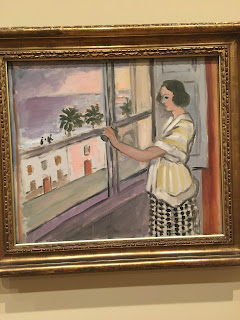Baltimore Museum of Art Trip

Henri Matisse Young Woman at the Window, Sunset Last week, we visited the Baltimore Museum of Art with the class. I found three works of art that I found very interesting. The one I found most interesting and ranked number 1 is this one on the right by Henri Matisse. It shows a young woman gazing out of a window from what seems like her bedroom. The composition used is Radiating Lines, because the lines around the window sill always lead your eye back to the woman, who is the focal point of the artwork. Your eye path begins at the woman, follows her gaze down her arm, and goes all around the window and what is outside, ultimately leading back to her face. The Design Wiki talks about lines and how they can suggest the presence of directional force acting on a point. In this artwork, the lines on the window sill seem to force your eyes around the painting, thus acting as a directional force. I liked this painting because it seemed very real and sad. I perceived the meani...